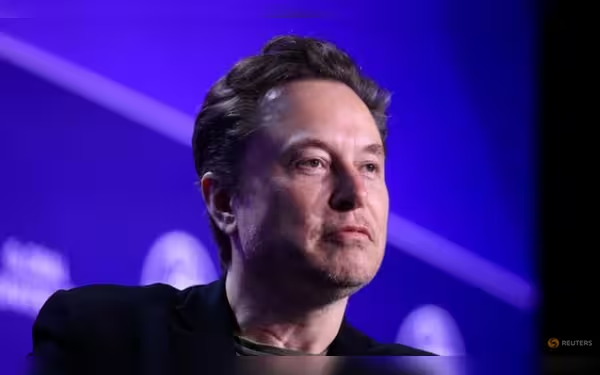Saturday, November 16, 2024 07:24 PM
Elon Musk Unveils Tesla Robotaxi at 'We, Robot' Event
- Musk introduces self-driving Cybercabs for passenger travel.
- Concerns arise over production speed and profitability.
- Tesla faces competition from established robotaxi services.
 Image Credits: channelnewsasia
Image Credits: channelnewsasiaElon Musk unveils Tesla's innovative robotaxi, raising excitement and skepticism about its future in transportation.
Tesla, the electric vehicle giant, has been making waves in the automotive industry for years, and its CEO, Elon Musk, is often at the center of this excitement. Recently, Musk unveiled a much-anticipated robotaxi at an event held on October 10. This robotaxi, which features two gull-wing doors and lacks traditional controls like a steering wheel and pedals, is part of Musk's vision for the future of transportation. The event, titled "We, Robot," took place at the Warner Bros studio near Los Angeles, California, and attracted a crowd of investors, analysts, and Tesla enthusiasts eager to see what Musk had in store.
Social media buzzed with excitement leading up to the event, with many sharing screenshots of invitations and speculating about the announcements. Musk himself described the atmosphere as a "futuristic world," showcasing the vibrant energy of the gathering. Among the attendees was Stellantis chairperson John Elkann and Musk's brother, Kimbal, highlighting the significance of the occasion.
At the heart of Musk's presentation was the concept of a fleet of self-driving taxis, dubbed Cybercabs, which passengers can summon through an app. This innovative approach not only aims to revolutionize how people travel but also allows individual Tesla owners to earn money by listing their vehicles as robotaxis. However, while the concept is exciting, investors and analysts have raised concerns about the challenges Tesla faces in bringing this technology to market.
Key questions linger regarding the speed of robotaxi production, the associated costs, and the potential profitability of this new venture. Additionally, there is keen interest in Tesla's progress with its Full Self-Driving (FSD) software, which is expected to be the backbone of the robotaxi service. Musk has previously expressed confidence in having operational robotaxis by 2020, but missed deadlines have led to skepticism.
As Tesla navigates these challenges, it is also contending with a potential decline in vehicle deliveries this year. The company has struggled to attract customers to its aging electric vehicle lineup, and significant price cuts aimed at boosting sales have put pressure on profit margins. Analysts suggest that Musk must demonstrate a working prototype and provide a clear strategy to outpace competitors like Alphabet's Waymo, which already operates uncrewed robotaxis in select U.S. cities.
While other companies have faced substantial losses in the robotaxi market due to complex technology and stringent regulations, Tesla's approach is distinct. Musk is focusing on using cameras and artificial intelligence instead of expensive hardware like lidar, which could help keep costs down. However, the FSD technology has faced scrutiny, especially following incidents involving fatal accidents.
The unveiling of Tesla's robotaxi marks a significant step in the company's journey toward redefining transportation. While the excitement surrounding the event is palpable, the road ahead is fraught with challenges. As Tesla strives to turn its ambitious vision into reality, it remains to be seen whether it can overcome the hurdles and deliver on its promises. The future of robotaxis could reshape how we think about travel, but only time will tell if Musk's bold predictions will come to fruition.













